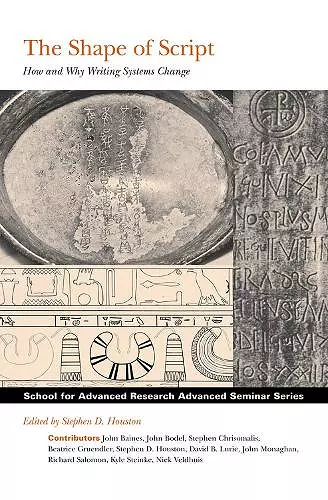Shape of Script
How and Why Writing Systems Change
Format:Paperback
Publisher:SAR Press
Published:30th Apr '12
Currently unavailable, our supplier has not provided us a restock date

Stephen D. Houston has spent decades studying the nature of writing systems, which “are so very basic as nodes of connection among many aspects of human experience,” such as language, communication, identity, technology, and the recording of memory. “One of the misconceptions about writing is that a particular system of script comes into existence, remains the same, and then ‘dies,’” said Houston.“This notion radically and wrongly dehistoricizes systems of writing. We now know that scripts exist as fluid sets of practices, shifting over long periods of time and in response to changing historical circumstances, conditions of learning, and arenas of patronage and use.” For this advanced seminar “The Shape of Script: How and Why Writing Systems Change,” 10 specialists convened to address “the question of what happens between the origins of a writing system and the time of eventual ‘script death,’ or extinction.” Although scholars are close to conceptualizing the way scripts emerge and pass into obsolescence, they are still far from explaining how scripts maintain themselves over time or how and why they change when they do. “This is unfortunate: writing is one of the central cultural productions in human history, yet its many modulations and shifts seem largely to be taken for granted, without need for explanation. Writing is a pivotal intermediary in many human transactions. But it needs to be brought back into the fold of anthropology, not as a marginal specialty but as an indispensable tool by which knowledge is transmitted.” The seminar, conceived as a capstone to a 10-year project to resuscitate and renovate the study of past writing systems within anthropology, brought together experts in script traditions including Egyptian hieroglyphs, Latin writing and Mediterranean alphabets, cuneiform, South Asian scripts, ancient Roman script, and premodern Arabic, Japanese, Chinese, and Mesoamerican writing systems. Using cross-cultural comparisons, the participants sought to understand the forces that influence the courses of writing systems. Houston emphasized the importance of examining context:“What is the physical, temporal, social, and cultural setting for the way the message of writing is accessed? That is where history enters the picture, within a place of contingency, challenge, and opportunity.” Among the questions driving the discussions were the following: What processes affected formal changes in scripts? What agents or actors were involved...
ISBN: 9781934691427
Dimensions: 226mm x 149mm x 27mm
Weight: 530g
300 pages